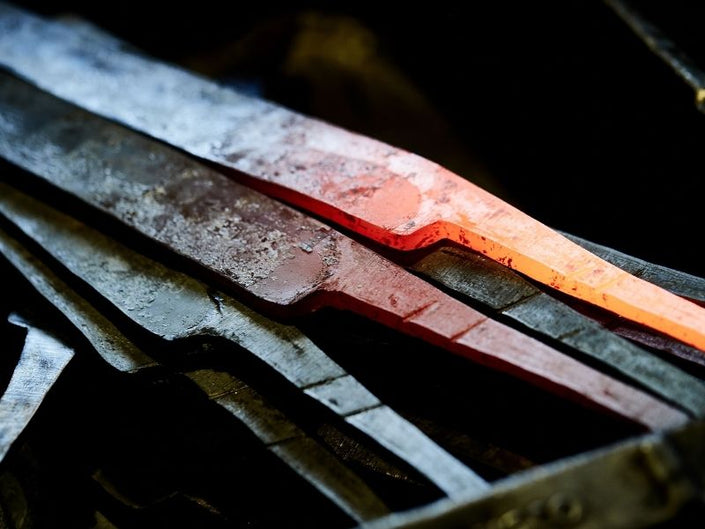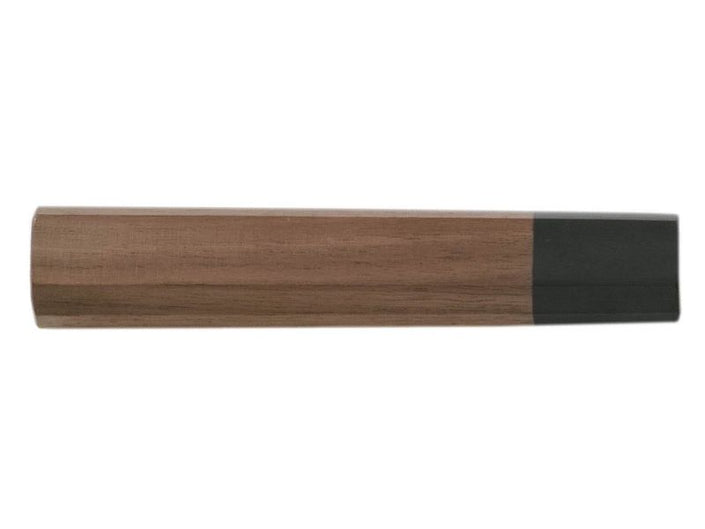
Feature
- Kirameki: Luxurious Series of Sakai Ichimonji Mitsuhide
- Blade: White steel No.1
- Handle: Walnut
Another choice
Silver Steel #3 Stainless Steel, Walnut Handle : click here
| Product number | Actual Blade Length (mm) | Full Length (mm) | Total Weight (g) |
|---|---|---|---|
| 1kb9w | 170 | 315 | 140 |
| Blade | Material Name | Handle |
|---|---|---|

Double Edged |
White Steel #1 | Walnut Handle |

Wa-Santoku
A Wa-Santoku is typically used in households around Japan. Unlike the standard Santoku, the Wa-Santoku has a traditional Japanese handle which shifts the balance point slightly,allowing more nimble cutting.

White Steel #1
Carbon Steel
White Steel #1 is the closest to traditional Japanese Tamahagane steel. It is extremely pure, with a very high carbon content allowing for maximum edge retention.
White Steel#1 is a higher Carbon content version of White Steel#2, making the steel harder and better at cutting, but also more difficult to sharpen.
This is the steel type most often recommended at Sakai Ichimonji for those seeking the ultimate edge and sharpness.
*NOTE: Carbon Steel is susceptible to rust if it is not properly cared for. Please clean and dry the blade regularly during use and after use.

Walnut Handle
Handle
This handle is made of Walnut, which is light and easy to work with. In Western Society, Walnut is commonly used for cutting boards,furniture and Gun Stocks due to its natural beauty and strength.

Forge Welded
Forging Process
A forge welded blade is essentially a blade made of more than one billet of steel. There are many variations of technique and steel combinations. At its most simple, a forge welded blade is two billets of steel heated and hammer together to form one unified piece. The steel will then be shaped by hammer into the desired blade shape. Hardened and tempered, then ground, sharpened and polished. A forge welded blade has higher strength and edge retention than a stamped blade.

Optional Engraving
Optional Engraving Service
Sakai Ichimonji provides complimentary engraving using either Japanese Kanji or English Alphabet. Please specify your preference. For details, please visit here
A knife store that has supported the history of knives and food culture in Japan.
It has been 600 years since the birth of swordmaking in the Sakai region of Japan. Sakai Ichimonji Mitsuhide's and it's craftsmen continue to build on that legacy by producing the finest blades in Japan.
This is where the culture of completing a dish of sashimi by "just cutting" and the culture of expressing sharpness as "taste" was born.
For 70 years, we have been connecting the spirit of Sakai's craftsmen with the passion of chefs in Osaka's kitchen equipment shopping district, known as the kitchen of Japan.
We are very happy that our knives can be used by people all over the world.
Precautions
After use, wash off any dirt and wipe thoroughly with a dry cloth to remove any moisture. This product is not for use with frozen foods.This product is handmade, so each piece will be different. Please use the weight and length listed as a guide. Each material is natural and may vary in color. It is not the same as the picture.We take great care with our inventory, but in the unlikely event that we are out of stock, we will contact you by email to let you know.

































